Ant Species
Although all ants may seem alike, they are divided into many different species based on their lifestyles and physical attributes. These living beings in fact have approximately 8800 species. Each species also has special admirable attributes. Now, let us discuss some of these species, their lifestyles and characteristics.
Leaf Cutter Ants
The specific characteristic of the leaf cutter ants also called "atta," is their habit of transporting the leaf pieces that they cut out on their heads. The ants hide under leaves that are quite large compared to their own sizes. These they secure in their closely shut chins. Therefore, the return voyage of worker ants after a day's work presents a very interesting picture. Anyone who sees this happening would feel as if the floor of the forest were alive and walking. In rain forests their actions remove about 15 percent of leaf production.19 The reason for their carrying leaf pieces is, of course, not protection from the sun. Ants do not utilize these leaf pieces as food either. Then, in what way do they use so many leaves?
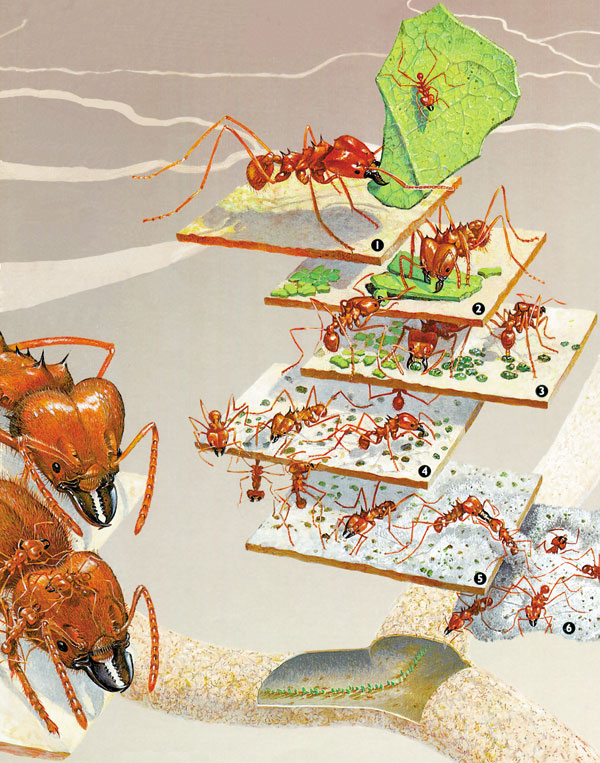 |
| 1. Inside the nest, slightly smaller workerschop leaves into bits. |
It has been discovered that, surprisingly, Attas use these leaves in fungus culturing. Ants cannot eat the leaves themselves, because they do not have enzymes in their bodies that could digest the cellulose in the leaves. Worker ants make a heap of these leaf pieces after chewing them and insert them into the garden substratum. In these chambers, they grow fungus on the leaves. This way, they obtain the required protein from the shoots of the fungus.20
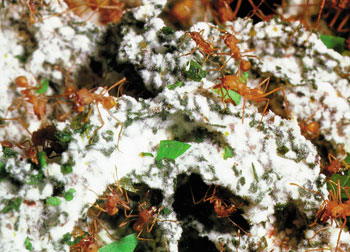 |
| Due to the symbiosis of leaf cutter ants and fungi, the ants obtain the protein they need for nutrition from the mushroom buds they grow on leaves. Above we see a mushroom garden tended by ants. |
However, when Attas are removed, the garden would normally begin to deteriorate and would soon be overwhelmed by weed fungi. Then, how can the Attas, who clean their gardens only before "planting," be protected against weed fungi? The trick of maintaining a pure fungus culture without constant weeding seems to depend upon the saliva the ants work into the compost as they chew it up. It is thought that the saliva contains an antibiotic that inhibits the growth of undesirable fungi. It probably contains a growth-promoter for the right fungus, too.21What one has to ponder upon is the following: How have these ants learned to cultivate fungus? Is it possible that one day one of the ants took a leaf in its mouth by coincidence and chewed it, and then again by chance, it placed this liquid that had become porridge-like on a dry leaf floor which, by sheer coincidence is a totally appropriate place, and other ants brought pieces of fungus and planted them there and, finally, the ants which had anticipated that some sort of food that they could eat would grow there, started cleaning the garden, throwing out unnecessary material, and harvesting? And then they went over and conveyed this process to the whole colony one by one? Also, why would they have carried all those leaves to their nests although they could not eat them?
Furthermore, how could these ants have created the saliva that they use while chewing the leaves for the production of fungi? Even it is thought that they may form this saliva, one way or the other, with what information could they produce an antibiotic in their saliva which prevents the formation of weed fungi? Does it not require having a significant knowledge of chemistry to achieve such a process? Even if they did have such knowledge - which is impossible- how could they apply it and get their saliva to have this antibiotic substance characteristic?
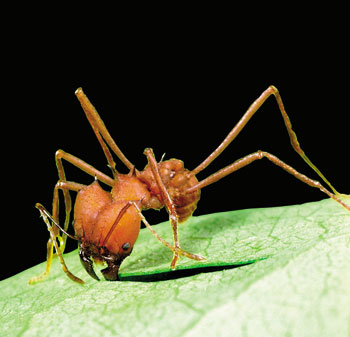 |
| Leaf cutter ant on duty |
When one thinks about how ants could realize such a miraculous event, hundreds of similar questions come up to none of which there are any answers.
On the other hand, if a single explanatory answer could be given, all these questions would have been answered. Ants have been designed and programmed to achieve the job they are performing. The observed event is sufficient to prove that ants are born or rather caused to be born knowing farming. Such complex behavioural patterns are not phenomena which may develop in stages and with time. They are the work of a comprehensive knowledge and a supreme intellect. Thus the claims by evolutionists that beneficial behaviour is selected in time and the required organs develop through mutations seem totally illogical. It is, of course, no one other than Allah who gives this knowledge to the ants from day one, and Who creates them with all these astonishing features. It is Allah who is the "Creator" (Sani). The features of the Atta ants we mention above set forth a picture we shall face frequently all throughout this book. We are talking about a living being without the ability to think, but which nevertheless achieves a great task displaying a tremendous intellect. This is hard for man to conceive of.
Then, what does this all mean?
There is only one answer and it is a simple one: If this animal has no capacity to think in order to enable it to do what it is doing, then its show of intellect, in fact, introduces us somebody else's Wisdom. The Creator Who has caused the ant to exist is letting this animal do things beyond its capacity to show His existence and superiority in His creation. The ant acts under Allah's inspiration and the intellect it displays is in fact, the Wisdom of Allah.
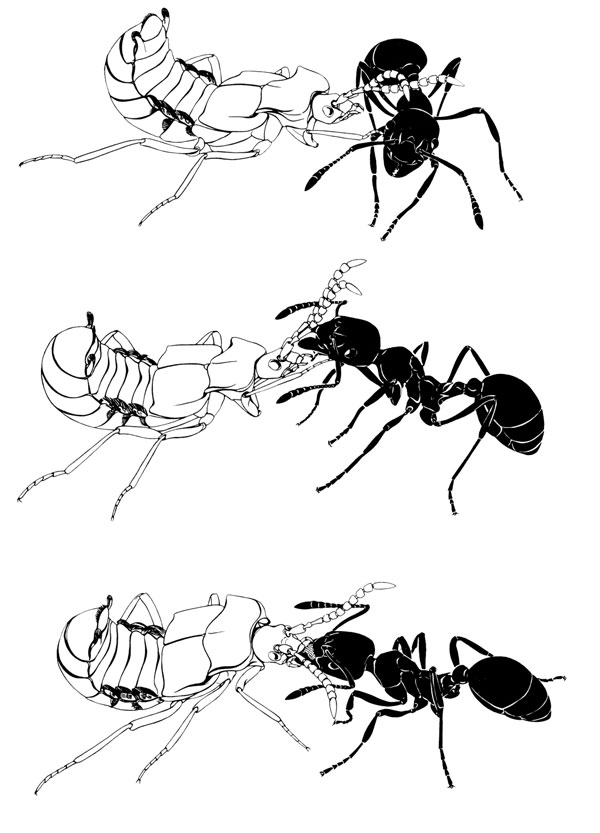 |
| In the picture on the above, we see the food exchange between a bug and an ant. Above, the bug touches the ant with its antennae. In the middle, the bud taps the ant's mouth with its forelegs. At the bottom, the ant presents a drop of liquid food to the imitating bug. |
Actually, a similar situation exists in the whole of the animal world. We meet creatures who display a very superior intellect, although they have neither an independent mind nor the capacity for judgement. The ant is one of the most striking of these and like other animals, acts, in fact, in accordance with the programme it has been given by the Will that trains it. It reflects the Wisdom and power of Possessor of that Will, that is, Allah.
The Attas' Interesting Defence Methods
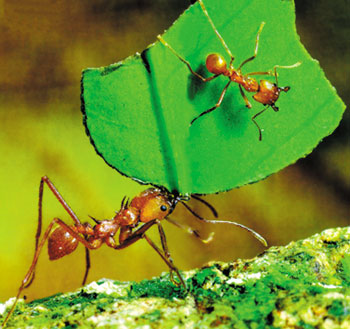 |
| Above we see an Atta, along with its smallsized guard, carrying a leaf. |
Medium-sized workers of the leaf cutter ant colony spend almost all their days in carrying leaves. It becomes difficult for them to protect themselves during this process, because they secure the leaves with the chins that they use for protecting themselves. Then, if they are not able to protect themselves, who does?
It has been observed that leaf cutter worker ants walk around with smaller size workers all the time. At first, it was thought that this was accidental. Then, the cause for this was researched and the finding, which was the result of a long analysis, was an astonishing example of cooperation.
Medium-sized ants, given the task of carrying leaves use an interesting defence system against a hostile type of fly. This hostile fly has chosen a special place to lay its eggs - the head portion of each ant. The maggot hatching from the egg would feed on the ant's head, eventually decapitating the ant. Without their smaller assistants, the worker ants are defenceless against this fly species that is always ready to attack. Under normal circumstances, the ants who, with their scissors like sharp mandibles, are able to chase away the flies trying to land on them, cannot do this while carrying leaves. Therefore, they place another ant to defend them, on the leaf that they carry and during the attack, these small guards fight against the enemy.23
Highways of Attas
The road that Attas use, while carrying the leaves they cut back to home, seems like a miniature highway. Ants who crawl slowly on it collect all twigs, small gravel, grass and wild plants and put them to one side. Thus, they make a clear path for themselves. After a long period of intensive work, this highway becomes straight and smooth as if built with a special device.
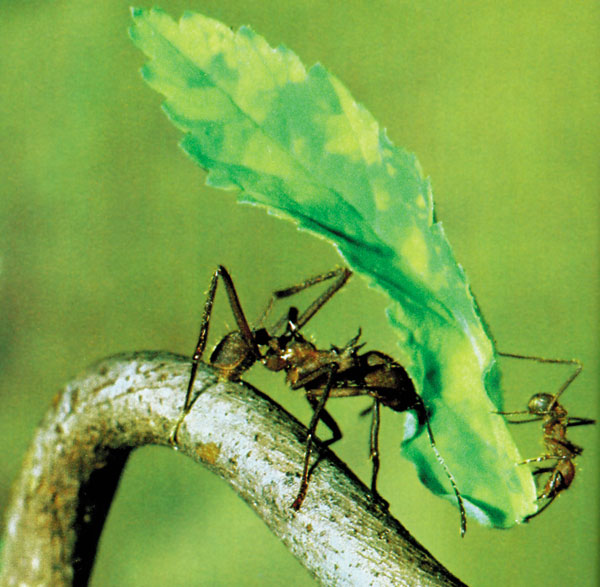 |
| The ant in the picture carries an extra small ant over the leaf it carries. The reason for this is to be able to be protected againt potential enemies that may attack it. |
The Atta colony consists of workers the size of a single grain of sand, soldiers who are many times larger and medium-sized "Marathon runners". Marathon runners run around to bring leaf pieces to the nest. These ants are so industrious that, scaled to human dimensions, each worker runs the equivalent of four-minute mile for 30-some miles (48 km.), with 500 pounds(227 kg.) slung over her shoulders.24
In an Atta nest, fist-sized galleries may be found that may go 6 metres deep. The miniature workers may move some 40 tons of soil while digging the many chambers of their huge nests.25 The building of these nests in a few years by ants is comparable in difficulty and high standard of professionalism to man's construction of the Great Wall of China.
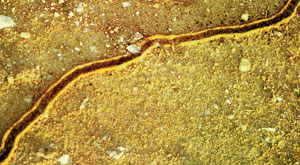 | 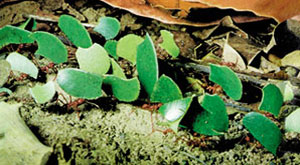 |
| When carrying the leaves they cut, Attas clear the road they use of all kinds of twig bits, gravel and grass remnants. Thus they prepare what amounts to a "highway" for themselves. | |
This is proof that the Attas may not be regarded as ordinary simple creatures. These ants, who are extremely hard working, are able to achieve complex tasks that a man would find difficult to do. Indeed, the only Possessor of might Who could have given them such skills is Allah. To say that they have acquired all these skills on their own and of their own accord would be illogical.
Leaf Cutting Technique of Attas
When the ant cuts the leaf with its mandibles, its whole body vibrates. Scientists have observed that this shaking fixes the leaves, thus facilitating the cutting. At the same time, the sound serves to attract other workers-all females-to the site to finish off the leaf.26 The ant rubs two small organs on his belly to produce this vibration that may be heard as a very slight sound by human beings. This vibration is sent through the body until reaching the sickle-like mandibles of the ant. By rapidly oscillating her hind end, this ant cuts out a crescent of leaf with vibrating mandibles in much the same manner as an electric carving knife.
This technique facilitates the cutting of the leaf. Yet, it is known that such vibrations serve another purpose as well. Seeing a leaf-cutting ant attracts others to the same place because many other plants in the regions where Attas live are poisonous. The testing of each leaf by an ant being such a risky procedure, they always go to locations where others have successfully completed their tasks.
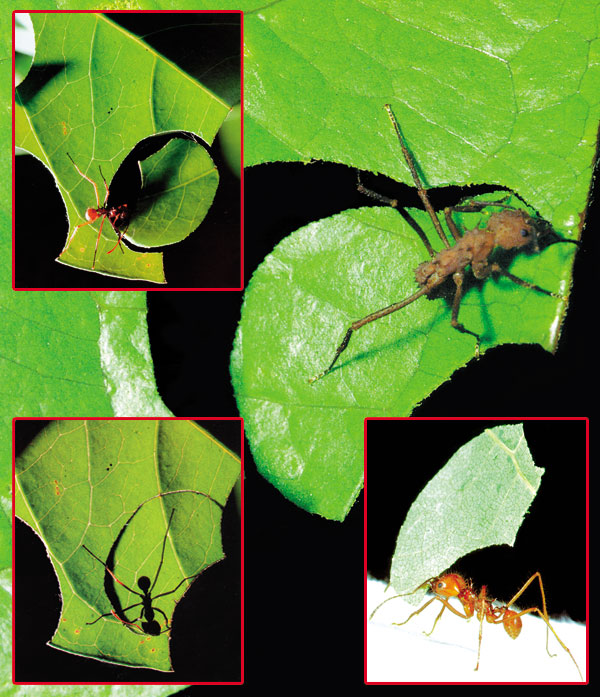 |
Weaver Ants
Weaver ants live in the trees building themselves nests out of leaves. By combining the leaves, they are able to form nests over a few trees, thus supporting a much larger population.
The stages of building are interesting. First, workers individually seek locations in the colony territory that are suitable for expansion. When they find a suitable branch, they disperse over the leaves of the branch and start pulling in the leaves from the sides. When an ant succeeds in bending a portion of a leaf, the workers close by also move towards it and start pulling the leaf together. If the leaf is wider than the size of the ant, or if it is necessary to pull two leaves together, the workers make suspension bridges between the points to be joined. Later on, some of the ants in the chain climb on the backs of the ants beside them, thus shortening the chain, and the joining of the ends of the leaf is achieved. When the leaf takes a tent-like shape, some of the ants keep holding the leaf with their legs and mandibles and others go back to the old nest and carry specially raised larvae to this region. Workers rub the larvae back and forth over the joints of the leaf, using them as a source of silk. With the silk secreted from an opening right below the mouths of the larvae, the leaves are fastened at the required locations. That is, the larvae are used as sewing machines.27
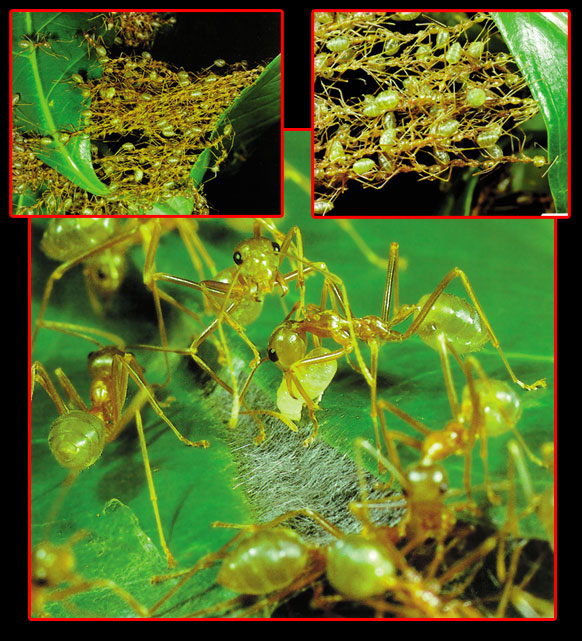 |
| Phases of nest building by weaver ants... In the first phase, ants pick the right leaves on the tree they plan to settle in, and combine them by pulling from two sides. Later on, they bring their silk producing larvae, as shown at the bottom, and sew the leaves together by using them as sewing machines. |
The silk glands of these spinning larvae are much larger, but they may be carried easily because they are smaller in size. The larvae give all their silk for the needs of the colonies instead of using them for themselves. Instead of producing silk slowly from their silk glands, they expel a broad thread of silk, and they do not even try to build their own cocoons. In the remaining portion of their lives, worker ants will do everything the larvae have to do for them. As is evident, these larvae live only as "silk manufacturers".28 How the ants could develop such cooperation has never been explained by scientists. Another unexplained point is how this behaviour emerged for the first time during this alleged term of evolution. As with the wings of the insects, the eyes of the vertebrates and other biological miracles, how such sophisticated and beneficial faculties developed by evolving from the first living beings is a phenomenon which cannot be explained by the basic principles of evolution. It is a dead end for defenders of evolution.
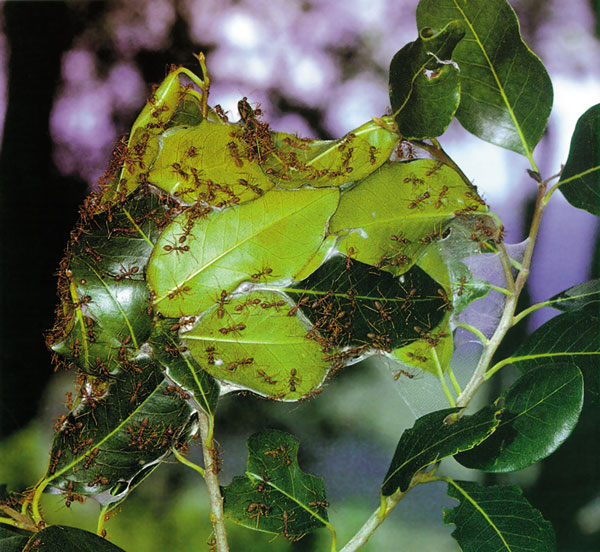 |
| A leaf nest prepared to meet all requirements |
It would not of course, be logical to say that one day the larvae came together and said that "some of us have to produce silk to meet the needs of the whole colony, so let us adjust our weights and silk glands accordingly." That would not be a very smart theory. We, therefore, have to admit that larvae have been created knowing what to do. In other words, Allah, Who created these larvae, shaped them in such a way as is suitable for their tasks.
Harvester Ants
Some of the ants, as mentioned before, are expert "farmers". Among these, it is possible to list harvester ants, apart from the Attas we talked about before.
The feeding mechanisms of harvester ants are quite sophisticated and complex as compared to the feeding mechanisms of other types of ants. These collect seeds and keep them in specially prepared rooms. These seeds, made up of starch, are used for producing the sugar that will feed the larvae and other workers. While many ants use the seeds and kernels as food, only harvester ants have a system based on gathering seeds and processing them.
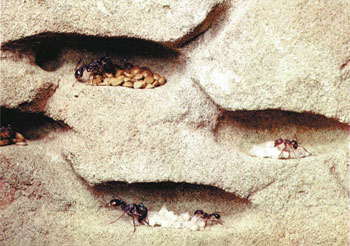 | 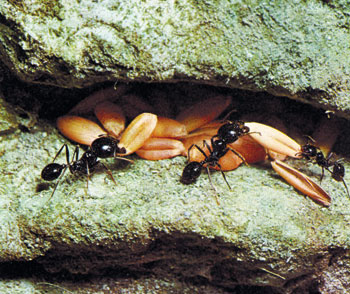 |
| In the chambers we see, seeds to be used in the arid season are stored by harvester ants. | Harvester ants carry starchy seeds to special chambers and convert them into a form to be used in the nourishment of workers. |
These ants collect the seeds in the growing season and store them for use in the arid season. In special rooms in the nest, they sort out the seeds from other objects mistakenly brought back. Some groups of ants stay in the nest by the hour, chewing the seeds' contents and thus producing so-called ant bread. The ants were once thought to use some learned process to convert the seeds' starch into the sugar they eat. It is now known that the abundant saliva they secrete while chewing accomplishes this transformation.29
The ants we speak of here have not, of course, had any education in chemistry. Neither can they anticipate that their saliva will transform the seeds they collect randomly into sugar that they can eat. Yet, the lives of these ants depend on a series of chemical transformations that they do not know about and cannot know about. When even men do not know of such a transformation process taking place in the bodies of the ants – and they have just learned the details in the last few years – how have the ants managed to be fed by this method for millenniums?
Honey Ants
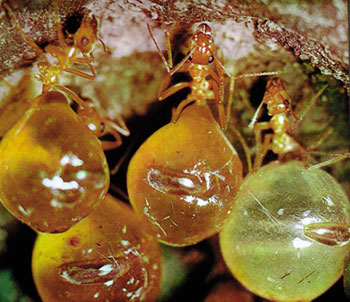 |
Many types of ants are fed with the digestive wastes of aphids called "honey". This substance in fact bears no relation to real honey. However, the digestive waste of aphids, which have fed on plant sap, is given this name because it contains a high proportion of sugar. Thus, the workers of this species, called honey ants, collect honey from aphids, coccidae, and flowers.
The ants' method of collecting honey from the aphid is very interesting. The ant approaches the aphid and starts shoving its belly. The aphid gives a drop of digestive waste to the ant. The ant starts shoving the belly of the aphid more and more to get more honey and sucks the liquid that comes out. Then how do they utilize this sugared food and what good is this food for them later on?
There is a great division of labour among honey ants in this phase. Some ants are used as "jars" to keep the nectar collected by other workers!…
In every nest, there is one queen, workers and also honey carriers. The colonies of these ants are usually located near the dwarf oak trees the workers can extract nectars from. After the workers carry the nectar, once having swallowed it, to their nests, they take it out of their mouths and pour it into the mouths of young workers who will keep the honey. These workers, nicknamed honeypots, use their own bodies to store the sweet liquid food the colony often needs to get through hard times in the desert.
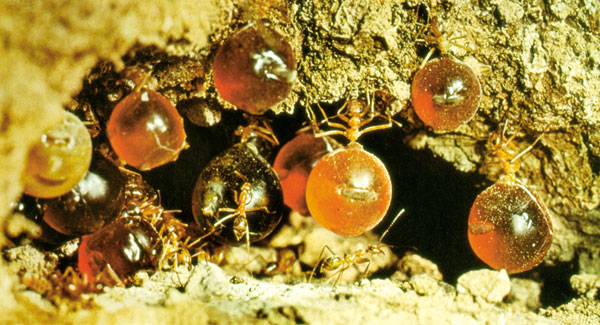 |
They are fed until they swell up to the size of blueberries. Then they dangle like amber globes from the ceilings of their chambers until called upon to regurgitate nectar to hungry sisters.30 While attached to this ceiling, they look like a small and translucent bunch of grapes. If any of them falls down, the workers return it to its previous position right away. Honey in the honey pots weighs almost 8 times as much as an ant.
In winter, or in the arid season, ordinary workers visit the honey pots to meet their daily food demands. The worker ant places its mouth on to the "pot's" and the pot exudes a small drop of honey from its store by contracting its muscles. The workers consume this honey of high nutritional value as food in adverse seasons.
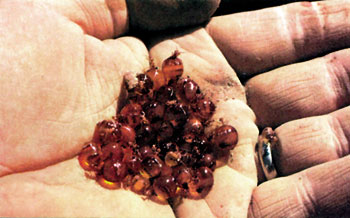 |
| As shown in the picture above, honey pots that have been inflated by storing food look like grapes. |
It is an interesting and awe-inspiring situation for a living being to reach a weight 8 times its own, having decided to serve as a honey pot, and to be able to live hanging from its feet without any harm coming to it. Why have they felt the need to accept such a difficult and dangerous position? Have they thought about this unique storage technique themselves and controlled their bodily developments accordingly? Just think, while a man cannot even control the slightest development in his body, how can an ant, who does not even have a brain in the real sense, do this on its own?
Honey ants display behavior that the evolution theory cannot explain. It is totally illogical to maintain that they have developed the honey storage method and the organs required for it by chance. In fact, in scientific sources, we meet many realistic statements on this and similar subjects. Take, for instance, the explanation of Prof. Etienne Rabaud, Director of the Institute of Biology of the Paris University:
These examples (for instance honey ants) show clearly that various organs have not been developed for performing certain functions by the living beings, although their prior existence has sometimes led to certain acts and tasks to be performed and sometimes not. This shows that the organs have not developed out of the adaptation by living beings to life conditions, but life conditions have arisen out of prior existence of such organs and out of their functions as we have seen. The following question may be asked as Darwin did: Does the event of clearing, or weeding out of one who loses the capacity to live, or the adaptation of organs to new conditions take place in this evolution? We contend that events have proven that such an evolution, or such a change, has not occurred. In fact, a totally different phenomenon has taken place.31
These explanations given by Professor Rabaud show us clearly a conclusion that anyone may arrive at by thinking with his conscience for just a very short time. A sole Creator Who is the real source of knowledge and intellect has created all living beings with their faultless organs and perfect behaviour. This truth has been expressed in the Qur'an as follows:
He is Allah, the Creator, the Maker, the Giver of Forms. To Him belong the Most Beautiful Names: Everything in the heavens and earth glorifies Him. He is the Almighty, the All-Wise. (Surat Al-Hashr, 24)
Wood Ants
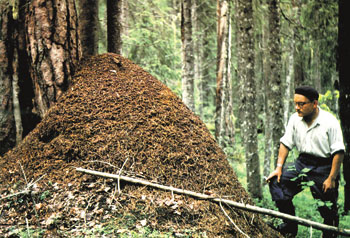 |
| In the picture, a wood ant nest is shown. The height of these nests built by wood ants from pine needles and twigs may reach approximately 2 metres. |
Wood ants are famous for the hills they build from pine needles and thin branches on top of their underground nests. The nest is usually founded around a tree log. The portion of the nest above ground, made up of twigs, leaf stems, and pine needles, is the roof of the nest. This roof may reach up to 2 metres in height, it prevents seepage of rain inside and regulates the temperature of the nest in very hot or very cold weather.32
Wood ants, like the others, are also very hard working. They keep re-decorating their nests continuously. They transfer the original surface layer to the lower layers in stages and they bring up material from the lower layers to replace the upper level. An interesting observation was made of the changes the ants make in the nest. Blue dye was sprayed on top of the hill of the nest and in four days it was observed that the top of the hill was again brown. Blue particles were found 8-10 cms below the surface. Within one month these particles went down to a depth of 40 cm. Subsequently, these blue particles have reached the surface once again.
Well, do these ants perform this continuous transportation process just for the sake of doing it? No. Researchers explain why wood ants engage in this perpetual act as follows: The perpetual motion dries the humid substances inside at the surface and prevents the formation of fungi. Otherwise, the ants would have a nest occupied by harmful fungi.
In such a situation there are two possibilities. One is that very long ago the ants, by their own research, discovered the fact that fungi develop in a humid environment, (something which man discovered as a result of long term scientific research) and developed the most rational method to eliminate this problem! The other possibility is that the conception and implementation of this perfect process can only be through inspiration by a supreme intellect. The impossibility of the first case is obvious. The One Who has inspired the ants to protect themselves from the fungi and shown them how to do so is, of course, the Almighty Allah.
Different Reproduction Methods of Wood Ants
The males and queens of wood ants are winged. However, they do not fly by a nuptial flight as other small ant species do. Mating is realized on the surface of the nest or some place nearby. After mating, the queen picks off its wings and does one of the following three things:
1. She returns to the nest where she has previously lived as a larva and leaves her eggs there.
2. Sometimes she leaves the nest with workers carrying her and looks for a new place to build a nest.
3. If she leaves on her own, she enters the nest of smaller related species, like the black ant Formica Fusca, and replaces the queen there. The queen leaves her eggs to be looked after by the Fusca workers in there. For a while there are both guest workers and host workers in the nest. However, since the hosts do not have a queen, after a while the workers die and the wood queens acquire an established nest without doing anything.33
He to whom the kingdom of the heavens and the earth belongs. He does not have a son and He has no partner in the Kingdom. He created everything and determined it most exactly. (Surat al-Furqan, 2)
In the tactics of queen wood ants discussed in section 3, a clear consciousness is observed. However, it is obvious that such consciousness may not belong to the ant itself. The queen ant has never seen any place other than the few square metres within her nest. She goes inside a colony which she has never seen or has not known of before, and knows who she should eliminate in that colony. She achieves this by overcoming all obstacles. All these factors prove beyond doubt that the queen ant is acting under inspiration. The above mentioned phenomena are clear proof of the power and sovereignty of Allah over all living creatures.
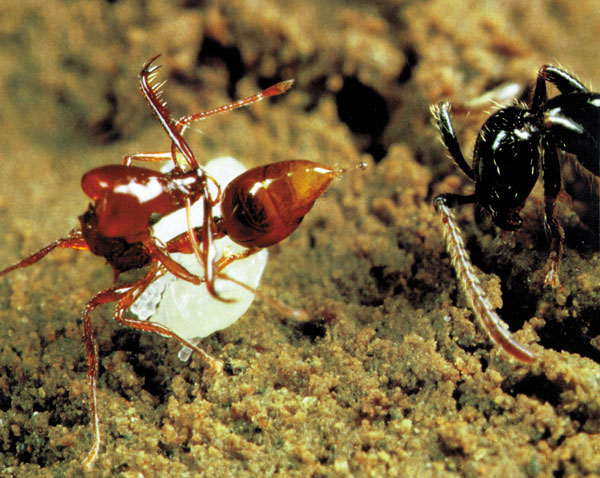 |
Chemical Weapon Production of Wood AntsWood ants are very well armed for war. When faced with danger, the wood ant bends the lower part of its abdomen from between its legs and squirts formic acid on its enemy. Or, during fighting, it bites the enemy with its pointed chin and injects acid in the wound. With these features, the animal acts like a chemical weapon. Its producing formic acid in its body without giving any harm to itself and its managing to use it in the best way are, no doubt, indications of a flawless design. |
Legionary Ants
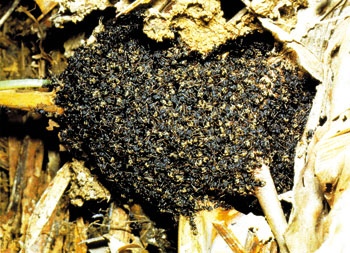 |
| Legionary ants who have formed a temporary nest by hanging on to each other with their feet. |
One of the most feared animals of the forests is the legionary ant The reason for the name "army" being given to this ant community is their acting u.nder a true military discipline.
Legionary ants are carnivores and they eat up everything in sight. Each ant is 6 to 12 millimetres long, but their incredible number and discipline make up for the disadvantage of their small size.
Direct sunlight may kill the legionary ants in a short time. Therefore they travel either at night or in the shade. Due to their sensitivity to light, they dig long tunnels while advancing. Most of the ants run in these tunnels without going outside. This does not decrease their speed, because they can dig the tunnels very fast with their strong mandibles. Thus, running is both fast and secret. Legionaries move as very large armies, going over all obstructions except fire and water, although they are totally blind.34
Legionary ants tear their prey apart where they find it and carry small pieces of it to their temporary nests. Quite a lot of food is needed for a legionary ant colony. The approximate daily need of a medium size colony, consisting of 80,000 adult ants and 30,000 larvae, is about half a gallon (2.27 litres) of animal product food.35
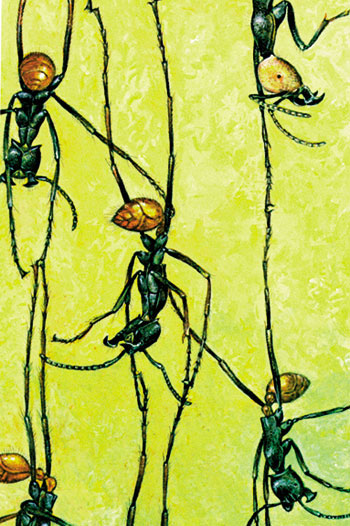 |
| Chained together, army ants create a living nest. On the move at all times, a colony of army ants can make no permanent home on the grounds or in trees. But each night the workers join together to create shelters out of their own bodies. First, several ants choose an object near the ground, like a log, and dangle from it with their claws interlocked. Other ants arrive, run down the strands, and fasten on until strands become ropes that fuse into a mass a meter across called a bivouac; home is the entire colony of 200,000 to 750,000 individuals. At the center rests the queen and her brood. In the morning ants begin to disentangle to go out and raid. |
Since legionary ants do not have a fixed nest, they are always moving. The movements and migrations of the colonies depend on the production cycle. The queen produces approximately 25-35,000 eggs during two days each month. A few days before the laying of the eggs, the colony halts and gathers in a wide area. The ants hang on to each other by their hook shaped legs and form a temporary nest. The empty space in the middle acts as a chamber ready for the queen and the new generation. Here, naturally, the legs and joints of the ants at the very top are subject to excessive loading. Yet, since they are built to endure weights several hundred times more than their own weights, they can hold the whole colony without much problem.36
To hunt most efficiently, the ants time their movements to the needs of a developing brood, alternating between sedentary and nomadic phases. During the resting period of about 20 days, the fat, immobile queen produces 50,000 to 100,000 eggs while other offspring lie in the quiescent pupal stage. On most days, workers, foraging only for themselves and the queen, make short raids from the nest in a rosette pattern. On each raid they vary their direction by an average of 123 degrees, thus avoiding recombing the same ground.37
Ants can unerringly calculate the 123° by themselves, something which man cannot calculate without an instrument. This would appear to indicate a thorough knowledge of mathematics. Yet ants do not know math, they cannot even count. So this shows that what they do is done by special inspiration, and not consciously.
When the first larvae hatch, workers collect food and, in the meantime, the community stays stationary. Pieces of food are fed directly to the larvae. The queen's being ready for laying again usually coincides with earlier larvae's transition into the pupa stage. In this stage, the community stops once again. The coinciding of the laying of eggs by the queen and the larvae going into the pupa stage indicates a conscious planning since it decreases the time for which the army stops.
The development of larvae prompts the older ants to start a new migration cycle. This is how it works: larvae give out a secretion when they are licked and cleaned by the workers. Research has shown that this fluid is effective in the decision to migrate.38
It would be a weakness of logic to claim that larvae which have not even gained the identity of an ant yet, have thought of secreting such a fluid and have directed the whole colony towards fulfilling their needs. The only thing that a smart observer can spot is the existence of a supreme Creator and His information and sovereignty that are all around us.
Velvet Ants
Velvet ants, which lead their lives in deserts, have excessively hairy bodies. Their natural coat serves as a heat-isolating layer. It preserves the heat in during the cold nights of the desert, and protects them from the heat during the day. Male velvet ants, because of their wings, are able to avoid the heat of the sand by flying. Yet female velvet ants have to walk around on hot sand, because they have no wings. They need this coat to be protected from the heat coming from ground as well as from the sun.
Then, what is the explanation for the insect having such a "coat" to protect it from adverse weather conditions? It is impossible to claim that the animal has acquired it by adapting to nature as part of the process of evolution, because this would lead to many questions remaining unanswered: Did the female velvet ants die due to high temperatures before having such a coat? If this was the case, how did they wait for generations to have a coat "by coincidence"? Through what kind of a coincidence did they get this body?
These questions are, of course, without answers, because these insects could not have obtained their "coats" that protect them from the heat by the mechanisms evolutionists keep suggesting, because these ants cannot live without this coat, and they have no time to wait for mutations which occur very seldom - and which are all harmful. It is clear that the animals have been designed from the outset to withstand the climate they live in.
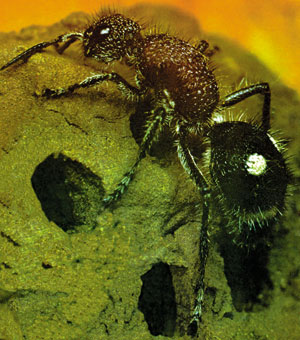 | 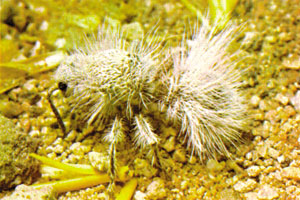 | |
| In these pictures two velvet ants of different species are seen. The common feature of velvet ants is their having a "coat" that would isolate them from the heat of the environment they inhabit. | ||
Female velvet ants look for any type of insect nest or bee hive that they can use after leaving their place of mating. When they do, they go inside the nest. They are equipped to fend off any eviction attempts and eventually they stay on in the nest, because the velvet ants have strong arms and a shield which allow them to go inside even bee hives. Their outer shells are exceptionally thick and hard. Zoologists claim that they have difficulty in piercing the chest of the velvet ant with a steel pin.39
Once inside, the velvet queen ant, which has all kinds of equipment with which to settle in the bee hives, starts feeding on the honey stock. Also, it leaves its eggs in the pupa cells of the bees or their cocoons. The ant larvae that hatch, feed on host pupae and later on they become pupae also. Bees leave the nest at the end of summer. Velvet ants spend the winter in this nest as pupae. According to one record, in a bee nest, there have been found 76 velvet ants and only two bees.40 This example shows how effective and successful the female velvet ant is in dealing with the female bee. The queen velvet ant, using subtle tactics, captures the nest from within and gains control of the nest herself.
What can be said here is that the velvet ant knows the bees very well and, moreover, knows very well how to deceive them, too. Then can it be anybody other than the Creator of the bee Who inspires her with the physical characteristics of the bee, its life style and nest structure? The only logical explanation is the acceptance of the existence of a sole Creator Who has created ants, bees and, in fact, all living beings.
Fire Ants
Fire ants are red insects of diminutive size. Yet they can achieve great things in spite of their smallness. The queens of these ants, which have 20 varieties in America alone, may produce as many as 5,000 eggs a day. While many ant species colonies have a few hundred workers, the colonies of this species have about half a million workers. A single mated fire ant queen can produce a colony of 240,000 workers.41
Fire ant workers very aggressively attack their prey with poisonous needles. It has been recorded that young fire ants have injured or even killed reptiles or baby deer. Also these aggressive ants may cause power failures by tearing up electricity cables. For a while they invaded South America and caused frightening damage. The journals and magazines of that year tell us that these ants have chewed through electrical cables and caused power cuts; they have caused damage to crops worth billions of dollars; they have caused motorways to collapse and have stung people, causing allergic shocks that have rendered them helpless. They have done all this with their powerful mandibles, even digging tunnels under roads causing motorways, roads to collapse and also causing other kinds of havoc in the environment.
Protection from Germs
American experts have tried various methods to prevent the above-mentioned damage done by fire ants. They considered spreading a contagious disease inside the colony by injecting germs into the flies the ants eat. Yet, astonishingly, it was seen that such flies with germs in no way hurt the ants. In the analysis it was found out that the ants have one of the most interesting defence systems in the world of living beings: a structure in their throats which protect them from germs… Because of this structure, the bacteria in anything that the ants eat were held at the throat without entering into the body.
But we have not come to the end of the protection systems of the fire ants that are the product of a superior intellect. They also spurt an anti-microbial fluid produced in their venom sacs around the nest and on the larvae. Thus, they achieve total disinfection of the nest and the larvae.42
These ants, equipped as they are with an extraordinary defence system, are certainly not aware of it. Can any person with a conscience claim that such a system has evolved by chance? Neither may it be claimed that the ants have founded such a system on their own. Then who is it that placed this filter in the throats of the ants, and who inspired them to produce an anti-microbial fluid? Without doubt, the Creator of such characteristics as man, ants and random luck cannot produce is Allah, Who is All-Knowing.
Hard Working Ants
The defense specialist fire ants are also highly skilled and hard working. They may build hills 30 cm high and 60 cm wide, or they can dig labyrinthine tunnels that can go 1.5 m deep under ground. In certain areas, fire ants have built small hills numbering up to 350. The capacity of such small beings to set up such huge nests, of course, depends on their industriousness. Then what is the power that makes the ants one of the most industrious living beings in the world? It is truly astonishing that they work all day long without stopping or resting, and build nests dispersed over vast areas. Not a single one says, "I worked too hard today, let me rest a bit," or "I don't want to work today. Let me sit in a corner." This is a subject that must be carefully considered. It must not be forgotten that there are times when human beings give in to exhaustion, even when they know they have to conclude a task, and there are times when they do not apply their will, because they are tired or they feel lazy. Yet ants display great effort and the will to bring any job they start to fruition. He Who gives the ants this will and resolve, that is even stronger than that of man's, is of course the sole master of all beings – Allah.
Master of Tactic Who can Penetrate Defence Systems
The most frightening enemy of fire ants is Solenopsis Davgeri, which is a parasitic ant species. This living being which can penetrate their multi-leveled defence system, which even man has difficulty in understanding, is yet another ant species. It is not known how this parasite ant can "seep into" the nest of the fire ant. Yet once it is in, the parasite ant immediately attacks the queen and clamps on to her antenna, legs or thorax. While the worker ants normally have to destroy any aggressor, why they do nothing against this particular creature seems hard to explain. Yet there is a simple answer. In itself attaching to her throat, the parasite mimics the queen's pheromones. Subsequently, the workers devote their efforts to feeding the parasites, half a dozen of which might yoke the queen, because they think that this parasite imitating her pheromones, is their queen. Their queen on the other hand starves to death in full view of the workers who serve her.43
Desert Ants
It is impossible to live in burning sand at 150°F for many living beings including man. Yet there are ants who can continue to live at this temperature. Well, how can Namib Ocymyrmex, which is a medium-sized, long-legged, black desert ant live in such intense heat?
A typical day in the desert does not start at a certain time for Namib ants. What starts the day is the standard sand surface temperature having reached 30 degrees. Right at this point the ants start getting out of their underground nests to look for food. Since their bodies are very cold, they cannot move straight and they walk with a wobble. Yet when the temperature increases, more ants come out and they start moving straighter and faster. The temperature where the in-out traffic of the nest is highest is 52.2 degrees. When the temperature goes above this point, the movement goes on, but as it reaches 67.8 degrees, the traffic stops. This temperature is reached about one hour before noon. As the temperature starts falling in the afternoon, the food search starts again and continues until the surface temperature drops to 30 degrees.
These ants may look for food for about six days away from the nest without becoming a prey to any animals. During this time they carry food home weighing 15-20 times their own weight.
Ants, who find it impossible to return to the nest when the temperature in the desert becomes impossibly high, use quite an interesting method for protection from heat. The air temperature decreases as one rises above the sand. For instance, while the temperature of the sand is 67.8 degrees, a little above it, the air temperature is 55 degrees. Therefore, when the sand surface temperature is above 52.2 degrees, ants climb on to objects like plants and stay there for a while to cool. The temperature of the small body of the ant soon falls to the ambient temperature. In tree trunks, the temperature varies between 30 and 38.3 degrees. These cooling breaks make it possible for the ant to look for food in burning heat, albeit intermittently.
In high temperatures, if the ant cannot find a cool place within a few seconds, it is going to die from heat. In fact, in sand temperatures of over 52.2 degrees, they take such a risk every time they leave their nests. Then how have desert ants escaped this inevitable end? Since they do not measure the temperature with a thermometre, we can safely say that they came into existence knowing what to do at what temperature – and knowing these things from the very first time they left the nest.
Yes, the desert ant has been created and equipped with special features to live in the desert. Allah, Who has created a sharp mandible for leaf cutter ants has inspired in the desert ants the knowledge of how to protect themselves.
Footnotes
19 National Geographic, July 1995, p. 100.
20 Bert Hölldobler-Edward O.Wilson, The Ants, Harvard University Press, 1990, p. 597-598.
21 The Insects, Peter Farb and the Editors of Time-Life Books, p. 164.
22 National Geographic, July 1995, p. 104.
23 National Geographic, July 1995, p. 100.
24 National Geographic, July 1995, p. 104.
25 National Geographic, July 1995, p. 100.
26 National Geographic, July 1995, p. 104.
27 Harun Yahya, For Men of Understanding, Ta-Ha Publishers, 1999, p. 148-149
28 Bert Hölldobler-Edward O.Wilson, The Ants, Harvard University Press, 1990, p. 626.
29 The Insects, Peter Farb and the Editors of Time-Life Books, p. 163.
30 National Geographic, June 1984, p. 803.
31 Bilim ve Teknik Dergisi (Journal of Science and Technics), June 1978, no: 127, p.44.
32 National Geographic, June 1984, p. 813.
33 Bert Hölldobler-Edward O.Wilson, The Ants, Harvard University Press, 1990, p. 176-177, 450.
34 The Insects, Peter Farb and the Editors of Time-Life Books, p. 164.
35 Encyclopaedia of Animals, Maurice-Robert Burton, C.P.B.C Publishing Ltd., p. 14.
36 National Geographic, June 1984, p. 797.
37 National Geographic, June 1984, p. 801.
38 Encyclopaedia of Animals, Maurice-Robert Burton, C.P.B.C Publishing Ltd., p. 15.
39 Encyclopaedia of Animals, Maurice-Robert Burton, C.P.B.C Publishing Ltd., p. 199.
40 Encyclopaedia of Animals, Maurice-Robert Burton, C.P.B.C Publishing Ltd.
41 New Scientist, November 4, 1995, p. 29.
42 Bert Hölldobler-Edward O.Wilson, Journey to The Ants, Harvard University Press, Cambridge, 1994, p. 6.
43 Science, Vol.263, 18 March 1994.
